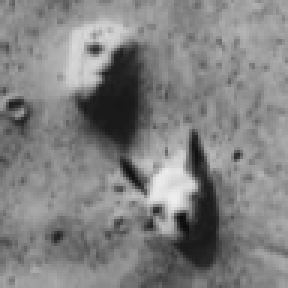Skip to comments.
Mars spacecraft settles into orbit around Red Planet - MRO - Mars Reconnaissance Orbiter
AP on Yahoo ^
| 9/12/06
| AP
Posted on 09/12/2006 6:30:41 PM PDT by NormsRevenge
PASADENA, Calif. - The most powerful spacecraft ever sent to Mars has settled into a nearly circular orbit, a move that allows scientists to begin studying the planet in unprecedented detail, NASA said Tuesday.
The Mars Reconnaissance Orbiter fired its thrusters for 12 minutes Monday to adjust to its final position six months after it arrived at the planet. Its altitude ranges between 155 to 196 miles above the surface.
"Getting to this point is a great achievement," said Dan Johnston, deputy mission manager at the space agency's Jet Propulsion Laboratory, which manages the $720 million mission.
Over the next several months, the orbiter will deploy its 33-foot antenna and remove a lens cap from one of its instruments. It will begin collecting data in November, and scientists expect the resolution of those images to be nine times higher.
The unmanned orbiter safely slipped into orbit around Mars in March after a seven-month, 310 million-mile journey. It joined three other spacecraft currently flying around the planet and two rovers rolling across the surface.
Several weeks after entering orbit, a high-resolution camera aboard the spacecraft beamed back a test image showing the planet's southern highlands and cratered surface.
The orbiter spent the last half year repeatedly dipping in to the upper atmosphere to shrink its orbit in a tricky process known as aerobraking.
TOPICS: Culture/Society; Government; US: California
KEYWORDS: mars; mro; nasa; orbit; orbiter; reconnaissance; redplanet; settles; spacecraft
To: NormsRevenge

This image provided by NASA Wednesday Sept. 6, 2006 shows the path of the Mars rover Opportunity as it nears the Martian crater Victoria. Victoria is the large crater near the bottom of this map. The gold line traces Opportunity's path eastward then southward from 'Eagle Crater,' where it landed, to Endurance Crater, where it spent six months, and nearly to Victoria. The south end of the line indicates Opportunity's location as of the rover's 930th Martian day, or sol, (Sept. 5, 2006). (AP Photo/NASA/JPL/MSSS/Ohio State University)
2
posted on
09/12/2006 6:31:21 PM PDT
by
NormsRevenge
(Semper Fi ......Help the "Pendleton 8' and families -- http://www.freerepublic.com/~normsrevenge/)
To: NormsRevenge

This image from NASA's Mars Reconnaissance Orbiter spacecraft generated from digital topography taken on March 24, 2006 shows an overview of the Mars terrain. China and Russia plan to launch a joint mission to Mars in 2009 to scoop up rocks from the red planet and one of its moons, a Chinese scientist said on Wednesday. REUTERS/NASA/JPL/Handout
3
posted on
09/12/2006 6:32:04 PM PDT
by
NormsRevenge
(Semper Fi ......Help the "Pendleton 8' and families -- http://www.freerepublic.com/~normsrevenge/)
To: NormsRevenge
I watch them both every day and I'm eagerly awaiting new photos from the Reconnaissance orbiter.
4
posted on
09/12/2006 6:33:08 PM PDT
by
cripplecreek
(If stupidity got us into this mess, then why can't it get us out?)
To: NormsRevenge
5
posted on
09/12/2006 6:33:58 PM PDT
by
zencat
(The universe is not what it appears, nor is it something else.)
To: NormsRevenge
Fantastic! Will it be able to talk to the rovers?
6
posted on
09/12/2006 6:34:57 PM PDT
by
ChadGore
(VISUALIZE 62,041,268 Bush fans. We Vote.)
To: NormsRevenge
Over the next several months, the orbiter will deploy its 33-foot antenna and remove a lens cap from one of its instruments
"Oh $hit, forgot to take off the lense cap!"
7
posted on
09/12/2006 6:35:09 PM PDT
by
verum ago
(To the UN:Diplomacy is useful only when backed by the threat of swift, merciless, and violent death.)
To: cripplecreek
8
posted on
09/12/2006 6:35:23 PM PDT
by
NormsRevenge
(Semper Fi ......Help the "Pendleton 8' and families -- http://www.freerepublic.com/~normsrevenge/)
To: NormsRevenge
Cool! Thanks for the update.
9
posted on
09/12/2006 6:36:11 PM PDT
by
Coyoteman
(I love the sound of beta decay in the morning!)
To: NormsRevenge
Meanwhile Islam considers the religious rammifications of using toilet paper.
To: NormsRevenge

Click da pic.
11
posted on
09/12/2006 6:37:27 PM PDT
by
cripplecreek
(If stupidity got us into this mess, then why can't it get us out?)
To: NormsRevenge
I think the Martians are getting tired of all this fuss:

12
posted on
09/12/2006 6:46:03 PM PDT
by
WestVirginiaRebel
(Common sense will do to liberalism what the atomic bomb did to Nagasaki-Rush Limbaugh)
To: WestVirginiaRebel
13
posted on
09/12/2006 6:51:29 PM PDT
by
ChristianDefender
(Never Give Your Enemy (ROP) A Foothold.)
To: Hammerhead
Meanwhile Islam considers the religious rammifications of using toilet paper.Best perspective of the day.
14
posted on
09/12/2006 7:12:10 PM PDT
by
corkoman
To: ChadGore
Fantastic! Will it be able to talk to the rovers?
Will it be able to see the flag the astronauts planted? :)
15
posted on
09/12/2006 7:18:39 PM PDT
by
P-40
(Al Qaeda was working in Iraq. They were just undocumented.)
To: zencat
16
posted on
09/12/2006 8:33:16 PM PDT
by
the_daug
To: WestVirginiaRebel
17
posted on
09/12/2006 8:39:11 PM PDT
by
Fiddlstix
(Warning! This Is A Subliminal Tagline! Read it at your own risk!(Presented by TagLines R US))
Disclaimer:
Opinions posted on Free Republic are those of the individual
posters and do not necessarily represent the opinion of Free Republic or its
management. All materials posted herein are protected by copyright law and the
exemption for fair use of copyrighted works.
FreeRepublic.com is powered by software copyright 2000-2008 John Robinson




